Ranunculus are some of the most stunning spring flowers, known for their vibrant colors and layered, rose-like petals. They make an excellent and lasting-lasting cut flower for arrangements and weddings. Ranunculus are relatively easy to grow if you follow a few key steps.
Here’s a beginner-friendly guide to help you cultivate healthy and beautiful ranunculus:
Choose the Right Variety
Ranunculus come in many varieties, from pastel shades to bold, vibrant colors. Some specialty hybrid varieties are cultivated specifically for cut flower use. Pick a variety suited to your end use, color preference, or garden style. Look for high-quality corms from a reputable supplier. You can see our avaible varieties HERE. If you want to save your corms, purchase non-patented varieties (see important note regarding propagation restrictions at the end of this guide).
Timing
- In cool climates (zones 3–7) you’ll want to start ranunculus indoors in late winter (at least 6–8 weeks before the last frost) to give them a head start.
- In mild/warm climates (zones 8–10) you can plant directly in the ground in fall or early spring for blooms in late winter or spring. Note that starting ranunculus indoors even in warmer climates may produce plants with stronger root systems that may bloom earlier than those started outside.
Preparing the Corms
Ranunculus corms look like little dried claws. To prepare them:
- Soak the corms in lukewarm water for 3–4 hours to plump them up. Don’t oversoak; they can rot.
- Some people will soak them in buckets with aerator systems. I personally have never done this and think it is an unnecessary step. If you want to take the time and extra effort, go for it.
Pre-sprouting (skip this step if you are planting directly outdoors)
- After soaking, place the corms with the claws facing down, in an open seed tray, shallow dish, or other type of container filled with well-draining potting soil. Make sure whatever you put them in has drainage holes.
- Cover with 1″ or so of potting soil.
- Place your corms in a cool spot that stays above freezing.
- Once your corms begin to show sign of growth (usually after about 14-21 days) make sure they are in an area with bright light This can come from natural light, or supplemental grow lights.
- Note, that you will need more light than what most window sills provide. A lack of light will produce thin, leggy stems and weak plants. A greenhouse or sunroom is ideal.
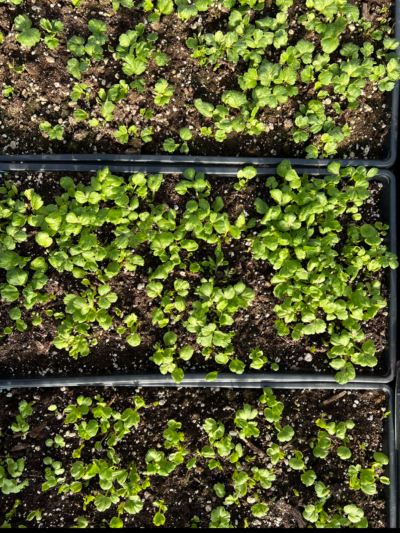
Pre-sprouting ranunculus in seed trays
Planting Outdoors
- Choose a spot with full sun (at least 6–8 hours daily).
- Plant in well-draining, nutrient-rich soil. Amend with compost if needed.
- Plant corms (or rooted plants) with the claws facing down, about 2″ deep and 4–6″ apart.
- Ranunculus also grow well in pots; just ensure your container has good drainage.

A well-rooted ranunculus ready for planting outdoors
Watering and Care
- Water thoroughly after planting, but avoid overwatering to prevent rot.
- Once the plants emerge, water them moderately, allowing the soil to dry slightly between waterings.
- Feed your ranunculus every 2–3 weeks with a balanced liquid fertilizer or one formulated for flowers.
- Apply a thin layer of mulch to regulate soil temperature and retain moisture.
- Ranunculus thrive in cool weather but dislike frost. If frost is expected, cover them with frost cloth or bring pots indoors.
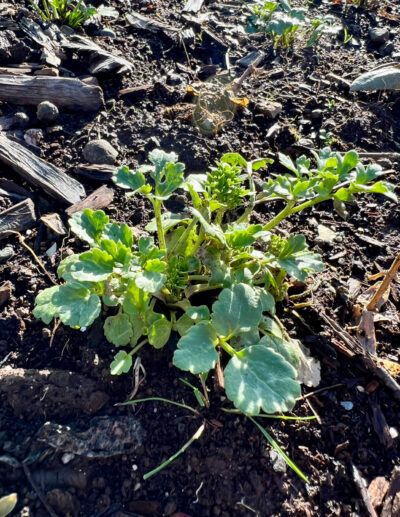
Ranunculus shorty after planting
Growth and Maintenance
- Ranunculus typically bloom from late spring until early summer. For me in zone 8b that is from mid-May until early July.
- Deadhead (remove spent flowers) to encourage more blooms and continuous flowering.
- Keep an eye out for voles, aphids, snails, and fungal issues. Proper care, spacing and good airflow can prevent many problems.
- When the weather becomes too hot, ranunculus enters dormancy to conserve energy and protect itself from heat stress. If you’re in a warmer climate, you can extend their growing season by providing partial shade, either with a shade cloth, by choosing a location that gets shaded in the late afternoon, or planting them earlier in the year to avoid peak summer heat.
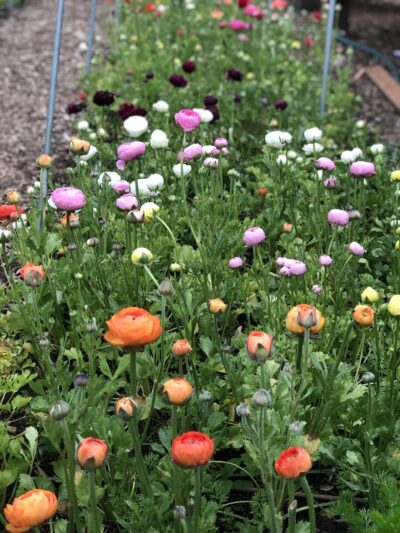
A mixed bed of ranunculus in June
Harvesting for Cut Flowers
- Harvest ranunculus flowers when the buds are colored and fully developed but not yet completely open. This stage is often referred to as the “marshmallow stage” because the bud feels soft and slightly spongy when gently squeezed. If you wait until the flower is fully open, its vase life will be shorter. You can shop our specialty cut flower varieties HERE
Tips for the Best Vase Life
- Harvest well-hydrated stems early in the morning or late in the evening when temperatures are cooler. This helps prevent wilting and stress to the flowers.
- Use sharp, clean scissors or snips to make a clean cut on the stem to minimize damage and reduce the risk of bacterial growth.
- Cut stems at a 45-degree angle to increase the surface area for water absorption and prevent the stem from sitting flat on the vase bottom.
- Condition the stems by placing the stems immediately in a bucket of clean water before arranging them in a vase. Allow them to condition for at least 1-2 hours in a cool, shaded area.
- Remove any foliage below the waterline to prevent bacterial growth, which can shorten vase life.
- Keep your arrangement in a cool area away from direct sunlight, drafts, or heat sources.
- Change vase water every 1-2 days and re-trim the stems slightly to ensure continued water uptake.
- Adding commercial flower food to the water can help nourish the flowers and inhibit bacterial growth.
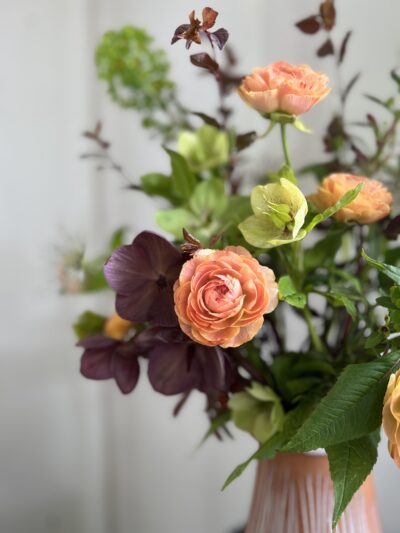
Ranunculus and hellebore arrangement
Post-Bloom Care for Plants
- When the foliage begins to yellow and die back, the plant is entering dormancy. This usually happens once daytime temperatures remain above 80 degrees. At this point, stop watering.
- In cooler climates, you can dig up the (non-patented) corms, clean them, and store them in a cool, dry place for replanting next season.
- In mild climates, you can leave them in the ground for potential reblooming.
An Important Note on Propagation
Many specialty hybrid ranunculus varieties, bred for unique colors, forms, or high-performance blooms, like Romance Ranunculus, are often patented or trademarked and intended to be grown as a cut flower for one season only and must be destroyed at the end of the season. These legal protections mean it is prohibited to propagate them without the owner’s permission, whether by saving seeds, saving corms, dividing corms, or any other method. Always check the labeling or do a search online to understand these restrictions.
By following these steps and being mindful of propagation restrictions, you can enjoy the beauty of ranunculus in your garden while adhering to ethical gardening practices!
Happy planting!🌸
Heidi

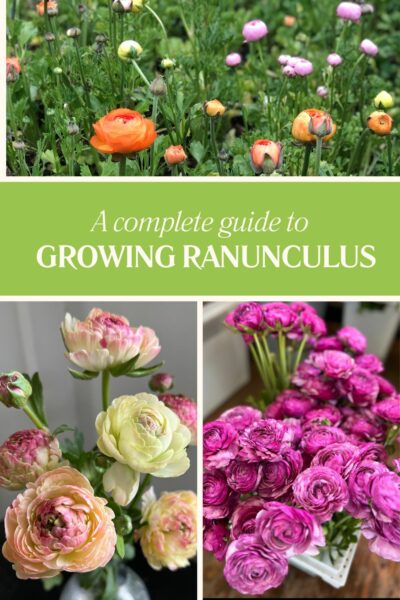
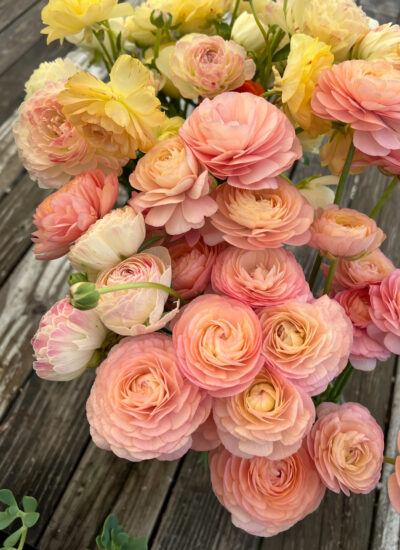
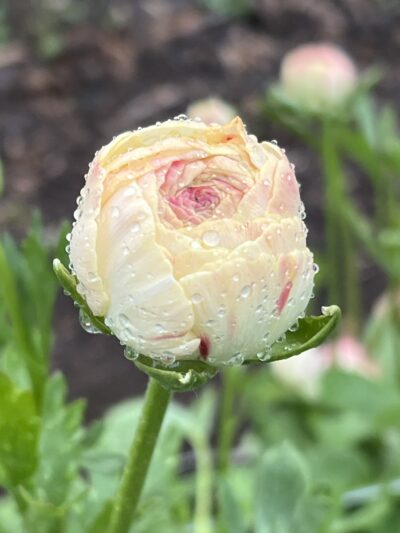
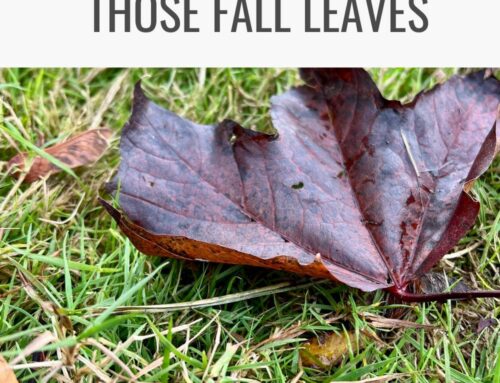

Leave A Comment